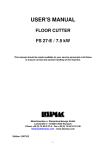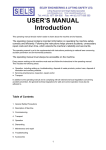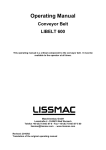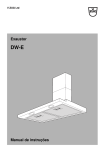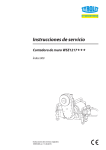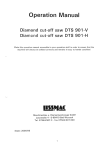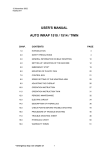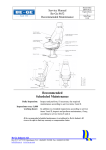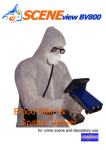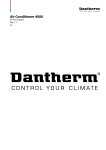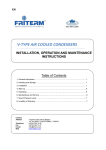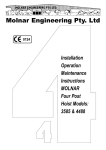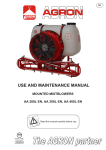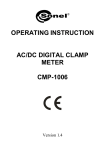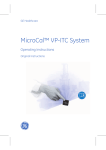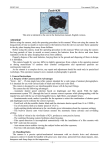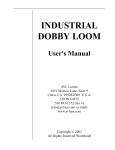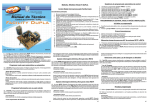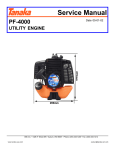Download OPERATION MANUAL
Transcript
OPERATION MANUAL Floor Cutter FS UNI-CUT This manual should be available to your service personnel at all times to ensure correct and careful handling of the machine. Maschinenbau u. Diamantwerkzeuge GmbH Mechanical Engineering – Diamond Tools Lanzstraße 4 - D-88410 Bad Wurzach Telefon +49 (0) 75 64/3 07-0 - Fax + 49 (0) 75 64/3 07-5 00 [email protected] - www.lissmac.com State:2007/02 1 Preface This operating manual should make it easier to learn to acquaint yourself with the machine and all its features. The operating manual contains important information on safe, efficient and technically correct operation. Following the instructions helps prevent accidents, unnecessary repair costs and down time which enhances the machine’s reliability and service life. The operating manual is yet to be supplemented with instructions pertaining to national laws concerning accident prevention and environmental protection. The operating manual must always be accessible on the machine. Every person working on the machine must read and follow the instructions in the operating manual. This includes the following areas: • Operation, including setting-up, troubleshooting during operation, disposal of waste products, product care, disposal of lubrication and auxiliary products. • Servicing (maintenance, inspection, repair) and/or • Transport In addition to the operating manual and in compliance with all binding national and local regulations concerning accident prevention, the general technical regulations for safe and correct operation must also be adhered to. Table of Contents 1. General Safety Precautions 2. Description of Machine 3. Commissioning 4. Transport 5. Operation 6. Maintenance 7. Spare parts list 8. Annex 10. Guarantee 2 1. General Safety Precautions 1.1 Warning Labels and Symbols used in this Manual Danger ! Not following the instructions can results in serious injuries or even death. Caution! Note! Not following the instructions can, under certain conditions, result in injuries. Not following the instructions can result in damage to the machine or other equipment. 1.2 General Safe Operating Procedures 1.2.1 The machine has been manufactured in keeping with the most recent technology and the recognized safety rules. Nevertheless there may be some risk of a hazard to life and limb of the user or third persons or impairments of the machine and other real assets respectively. 1.2.2 Use the machine only in good working conditions and follow all procedures concerning correct and safe operation, as outlined in the manual! This applies specifically to malfunctions that can jeopardize safety! Take immediate action to eliminate troubles! 1.2.3 This floor cutter is intended for cutting concrete or asphalt exclusively. The cutting of wood, plastic material or metal (except concrete reinforcements) is not permitted! Any other utilisation of this floor cutter is considered inadmissible. The manufacturer/supplier is not liable for any damage caused by undue application. Correct operation also requires following instructions in the operating manual as well as adhering to inspection and maintenance procedures. 1.3 Organizational measures 1.3.1 Always keep the operating manual close to the machine and easily accessible! 1.3.2 Follow all laws and regulations concerning accident prevention and environmental compliance listed in the supplement to this operating manual. 3 1.3.3 Any personnel working on the machine must read this operating manual, especially this chapter on safety precautions, prior to beginning. Learning on the job is too late! This especially applies to persons who work occasionally on the machine (like setup or maintenance crews). 1.3.4 Perform regular spot checks to ensure that personnel are doing their jobs in a safe and conscientious manner and that they are adhering to the instructions in the operating manual. 1.3.5 Use personal protective equipment whenever necessary or when required by regulations! 1.3.6 Pay attention to all safety and danger warning labels located on the machine! 1.3.7 Keep all safety and danger warning labels in/on the machine completely legible! 1.3.8 Immediately stop the machine and notify parties in charge when performing safety-related changes on the machine or its operation or becoming aware of any trouble of this kind! 1.3.9 Make no alterations and do not add componentry or rebuild the machine without permission from the manufacturer! 1.3.10 Use only original spare parts! 1.3.11 Perform all scheduled inspections as needed, or use the scheduled intervals as outlined in the operating manual! 1.3.12 For carrying out maintenance work, adequate workshop equipment is indispensable. 1.4 Qualifications for Selecting Operators; Fundamental Responsibilities 1.4.1 Only personnel of proven reliability are allowed to operated the machine. Observe legal minimum age requirements! 1.4.2 Use only qualified and trained personnel. Clearly define staff responsibilities concerning operation of machine, setup, maintenance, and repair works! 1.4.3 Ensure that the floor cutter is handled only by persons appointed to do so! 1.4.4 Define machine operator’s responsibility – also in respect to road traffic regulations – and his ability to object to instructions not in compliance with the safety regulations! 4 1.4.5 Apprentices, new employees, or personnel receiving general training must be supervised at all times by an experienced operator while working on the machine! 1.4.6 Any work at the electrical equipment of the floor cutter must be carried out by a qualified electrician only or a trained person under the supervision of a qualified electrician, in accordance with the rules and standards for electronics. 1.5 Safety Notice to Certain Operation Times 1.5.1 Normal Operation 1.5.1.1 Do not perform procedures that may present a safety risk! 1.5.1.2 Take steps to ensure the machine is used only when it is in a safe, operational state! 1.5.1.3 Machine must be examined for externally visible damage at least once per shift. Report any changes (including performance) to the appropriate parties in charge at once. If necessary, immediately stop and secure the machine! 1.5.1.4 Immediately stop and secure the machine when malfunctioning! Promptly fix the problem! 1.5.1.5 Prior to starting work, familiarize yourself with the locality and its environment.The environment may include obstacles within the working and traffic area, safe floor load, necessary protection of the site towards public traffic areas, first aid in case of accident. 1.5.2 Using the Floor Cutter for Extracurricular Jobs, Maintenance Procedures, Troubleshooting; Waste Disposal 1.5.2.1 Follow the instructions in the operating manual when adjusting, maintaining and inspecting componentry and performing scheduled work. This includes the replacement of parts! Only qualified personnel are allowed to perform these activities. 1.5.2.2 Notify operators of any maintenance or additional work prior to performing! Appoint a supervisor! 1.5.2.3 When the machine is completely turned off for maintenance or repair work, it must be safeguarded against an unexpected restart! 5 1.5.2.4 Prior to cleaning the machine with water or by steam jet (high pressure steam jet) or with other cleansing agents, cover and seal all openings into which, due to safety or functional reasons, water/steam/cleansing agent may not penetrate. Particularly protect endangered electric motors and switches. 1.5.2.5 Completely remove all covers/tape after cleaning! 1.5.2.6 Tighten any loose screws after performing maintenance or repair work! 1.5.2.7 If the protective devices on the machine need to be removed for setting up, maintenance or repair work, they must be reassembled immediately afterwards and tested for their safety features to ensure safe operation! 1.5.2.8 Dispose of lubrication and auxiliary devices as well as spare parts in a safe and environmentally friendly manner. 1.6 Precautions for Special Types of Danger 1.6.1 Electrical Power 1.6.1.1 Use only original fuses with the electrical current for which they were designed! Immediately turn off the machine when encountering power supply problems! 1.6.1.2 Any work on electrical equipment must be performed by a qualified electrician only or by trained persons under the supervision of a qualified electrician, in compliance with the regulations for electrical engineering. 1.6.1.3 Regularly inspect/check the machine’s electrical condition. Problems, such as loose connections (e.g. damaged cables) must be immediately repaired. 1.6.2 Dust 1.6.2.1 Observe all national regulations and standards when working in small spaces! 1.6.3 Noise 1.6.3.1 Wear officially prescribed personal ear protection! 6 1.7 Transport 1.7.1 Ensure that your hoisting gear and load suspension devices have adequate carrying capacity. 1.7.2 Have an experienced coordinator direct the lifting process! 1.7.3 Lift the machines using only approved lifting equipment as per the instructions given in the operating manual (striking points for loading procedures)! 1.7.4 Use only a vehicle providing sufficient carrying capacity for transporting the machine! 1.7.5 Secure the load. Use the appropriate striking points! 1.7.6 Turn off the power even when moving the machine only a small distance! Before restarting, ensure the machine is securely connected! 1.7.7 Always follow the instructions in the operating manual when restarting! 2. Description of Machine Componentry 2.1 Component Overview Pos. 1 Steering Rod Pos. 2 Operation Desk Pos. 3 Driverseat Pos. 5 Diesel tank Pos. 6 Saw blade protection cap Pos. 7 Motor frame Pos. 8 Saw head with hydraulic motor, guidance elements, and saw blade protection cap Pos. 9 Travelling gear Pos. 10 Hydraulic tank Pos. 11 Striking points Content: diesel engine, steering, hydraulic pump Content: steering, gear 7 8 2.2 Protection Devices Pos. 6 Saw blade protection cap 2.3. Technical Data Max. cut depth Max. saw blade diameter Saw blade holder Performance (kW/HP) Fuel Tank content Regular cutting motion Rapid cutting motion Saw blade speed, infinitely variable (electronic) Raising of saw blade Lowering of saw blade Hydraulic tank Weight including sludge extractor Dimensions FS UNI-CUT 630 mm 1500 mm 35 mm 98 / 133 Diesel 90 l 0-22 m/min. 0-60 m/min. 700 – 2500 RPM Hydraulic motor infinitely variable 50 l 2030 kg 2700/1100/1800 mm 2.4. Accessories - Saw blade protection cap ∅ 1200/1500 mm - Sludge extraction 2.5. Perceived noise level of FS UNI-CUT Guaranteed sound level = 105 dB(A) WARNING! Ear muffs must be worn if a 90 dB(A) noise level is exceeded! Sound ranging method in accordance with ISO 3744, 3862 and Regulation 2000/14/EG. 9 3. Commissioning 3.1 Operation desk Prior to starting the floor cutter, the operator has to make himself familiar with the machine. Meaning of the symbols: 12. Water pump ON - OFF 13. Hydraulic oil temperature is too high (green light) / hydraulic oil level (red light) is too low (light must not burn during operation) 14. Current supply (light burns during operation) 15. Preheating (light burns during start-up) ∗ required if outside temperatures are low 16. Emergency cut-off 17. Battery charging control (light must not burn during operation) 18. Motor oil pressure (light must not burn during operation) 19. Air filter (light must not burn during operation) ∗ change dirty cartridge (see 6.1) 20. Working hours counting device 21. Cooling water temperature 22. Sludge extraction ON - OFF 23. Saw blade change-over switch 0 = Off 1 = left 2 = right 24. Control lever for direction of motion and cutting speed (must always be in middle position at the start) Control lever forward = forward motion Control lever backward = reverse motion Button pressed down = rapid cutting motion Button up = regular cutting motion Attention! The rate of speed is set by control knob (pos. 25) 26. Gas lever for diesel engine 10 27. Vertical adjustment of saw protection cap Lever forward = saw cap up Lever backward = saw cap down Lever in middle = saw cap stops Atttention This lever also controls the feed motion of the saw cap. Wide deflection = increased feed motion 28. Lever Lever forward Lever backward Lever in middle Attention = = = saw blade up saw blade down saw blade stops This control knob (pos. 29) controls the rate of speed of the saw blade. Wide deflection = increased feed motion 30. Working pressure during sawing process 31. Saw blade speed control 32. Saw blade speed 33. Change of cutting direction - When reversing the cutting direction, the steering has also to be changed 34. Electronic feed motion ON - OFF 35. Socket for cooling water controller - red light burning = insufficient cooling water 36. Ignition lock 37. Connection for programming device 38. Sockets 3.2 Connections / lubrication and auxiliary devices - When delivered, the floor cutter is filled with HD-oil and diesel fuel. Anyway, these should be checked. ∗ HD-oil level gauge (pos. 47) ∗ Fuel-level gauge (pos. 48) ∗ Couple cooling water hose (pos. 42) 11 12 3.3 Assembly of saw blade - All switches on the operation desk must be in position “0” - Start motor with ignition key (pos. 36)en - Move saw blade drive to highest position ∗ lever pos. 28 ∗ control knob pos. 29 Danger! - Switch off ignition (pos. 21) - Remove eye bolts (pos. 39+40) - Uncouple extraction hose and undo saw blade cover - Remove all screws (pos. 41) - Remove pressure disk and insert saw blade Attention! * Clean flange surfaces * Arrows indicating direction of rotation (arrow on the blade) and protection cap must coincide (synchronous saws) - Mount the pressure disk and screws (pos. 41) - Assemble saw blade cover and put back extraction hose shoe 13 14 3.4 Preparations for start - Put the floor cutter in position ∗ Steering rod disk and saw blade (or rear side marker) are positioned above the cutting line *Couple water hose at pos. 42 or at extraction point - Open water plugs (pos. 42) - Set saw blade speed control knob (pos. 31) to “0” - Select sense of rotation of saw blade (pos. 23) - Put diesel engine gas lever (pos. 26) in „full throttle“ position - Adjust speed with control knob (pos. 31) – see table below ∅ mm 45m/sec. (concrete) 55m/sec. (asphalt) 400 500 600 700 800 900 1000 1100 1200 1500 215 0 263 0 1720 1430 1230 1080 960 860 780 720 580 2100 1750 1500 1310 1170 1050 960 880 700 ∅ mm 45m/sec. (Concrete) 55m/sec. (asphalt) - Switch on water pump (pos. 12) - Set feed motion control knob to “zero” (pos. 29) - Put lever (pos. 28) in „down“ position - Slowly initiate the dipping motion with the feed motion control knob - until the saw blade starts cutting Attention! Is the saw blade provided with sufficient cooling water? - Put the cut depth indicator (pos. 43) to “zero” - Dip the saw blade to desired cut depth (mm) (indicator pos. 43) ∗ Control knob (pos. 29) ∗ Lever (pos. 28) - Set control knob (pos. 25) to “zero” - Push the steering lever (pos. 24) forward (button is not pressed down) - Slowly initiate feed motion with control knob (pos. 25) * If required, switch on electronic control system (pos. 34) – see 5.2 3.5 Regular / rapid cutting mode 3.5.1 Regular cutting motion - Steering lever (pos. 24) is in middle position - Put control knob (pos. 25) to “zero” - Start diesel engine by ignition key (pos. 36) - Actuate gas lever (pos. 26) ∗ Define desired maximum speed - Push steering lever (pos. 24) into desired direction of motion - Start movement by control knob (pos. 25) 3.5.2 Rapid cutting motion - Proceed as indicated under 4.1.1 „normal cutting motion” - Simultaneously, button on steering lever (pos. 24) pressed down 15 16 4. Transport Displacement by crane - Has the crane enough carrying capacity? - Fix quadruple suspension gear with adequate carrying capacity using jack rings provided (pos. 11) - Lift carefully Danger! - Do not allow any persons to loiter under suspended loads at any time! - Always keep an eye on the floor cutter! 5. Operation 5.1 Regular cutting operation - Start preparations (see 3.4) 5.2 Cutting with electronically controlled feed function (applicable for reinforced concrete only) - Start electronical control (pos. 34) - Push steering lever (pos. 24) in direction of motion - Raise speed by turning control knob (pos. 25) Attention! If the rate of speed is selected too high, there is a risk of considerable fluctuations of the feed motion due to electronical control 17 18 5.3 Cooling water - Make sure that the saw blade is supplied with sufficient cooling water ∗ Use only clean water! ∗ Do not buckle hose! 5.4 Choice of saw blade See the “Lissmac Diamond Tools“ brochure. Only use saw blades recommended by the manufacturer. 5.5 Change from right to left cutting - Stop diesel engine (pos. 36) - Dismount steering rod lifter (pos. 44) - Remove hexagon screws (pos. 45) - Lift steering rod and suspend in rope - Pivot the sawing unit to middle position - Mount HD cylinder from pos. 46 to opposite side (introduce from above first) - Pivot the whole sawing unit to left side - Fix the sawing unit with straining screws again (pos. 45) - Reassemble steering rod (pos. 1) and steering rod lifter (pos. 44) at left side - Fix the driver seat at the other side - Pivot operation desk accordingly - Do not forget to change the sense of rotation (pos. 23) of the saw blade Attention: If the saw blade was already fixed, this needs to be turned as well (see 3.3) 19 6. Maintenance 6.1 Maintenance firstly change hydraulic oil change hydraulic filter check hydraulic oil level lubricator nipples Saw blade guiding element Check cooling water filter Check hoses and screwed connections of hydraulic system for tightness/damage daily weekly monthlyh 50 h 50 h yearly X X warning light ON every „x“ operating hours 500 h 500 h X X X X 20 h X Diesel engine see „Deutz“ operating manual Please observe the operating instruction of the engine manufacturer (you will find it attached to each new machine). Especially observe the safety and maintenance instructions. 20 6.2 Lubrications and auxiliary devices - Diesel engine see Deutz operating manual - Lubricator nipple ∗ Energrease LS2 BP 7. Spare Parts / Wearing Parts Designation Lissmac Item No. Deutz Ident. No. Engine oil filter 206599 01174418 Fuel filter 206598 01181245 Filter / water separator 207502 01319822 Air filter cartridge 204638 26510342 Safety cartridge (air filter) 204640 26510343 Hydraulic filter (Argo) 204554 V3.0923-08 Engine oil 15W40 (without filter change) approx. 8.5 litres Engine oil 15W40 (with filter change) approx. 10 litres Hydraulic oil BP-Bartran HV68 approx. 55 litres Driving wheel 207676 Hydraulic motor with brake 206529 Hydraulic motor without brake 206530 Starter battery 402115 Silencer 691678 Driver seat 206553 Wheel / steering roller / rod 207344 Water pump 207405 Water plug 3/4" 280011 HD level indicator 203730 Throttle linkage, complete 681118 HD manometer 0-600 bar 206566 HD mini-measuring hose 206567 Rotary shaft seal 80x100x7 206550 Conical nipple V-Seal 207168 Seal bushing 628178 O-ring 42x2 201550 Wearing plate / saw blade 628132 Sealing pack for HD engine 207728 Sealing pack for drive gear 681262 Guiding element saw blade (Ø500/628143)-(Ø1000/628241)protection S-green (Ø1200/628250) Wearing plates / saw protection (Ø500/628140)-(Ø1000/628247)cap (Ø1200/628252) Wearing plates / extraction hose (Ø500/628208)-(Ø1000/628256)shoe (Ø1200/628267) 21 10. Guarantee The guarantee time for this machine is 12 months. Guarantee for the following wearing parts will be given only when the wearing is not due to working conditions. Wearing parts are parts which are subject to wear and tear in working conditions due to intended use of the machine. The time of wearing is not defineable in a uniform way, it depends on their application intensity. The wearing parts of each specific machine have to be attended, adjusted and, if necessary, exchanged in accordance with the user’s manual of the manufacturer. For wearing due to working conditions, no warranty claims will be accepted. • • • • • • • • • • • • • • • • • • • • • • • • • • • • • • • Advance and driving elements as tooth racks, toothed wheels, pinions, spindles, spindle nuts, spindle bearings, ropes, chains, chain wheels, belts Gaskets and washers, cables, hoses, collars, plugs, ccouplings and switches for pneumatic and hydraulic systems, water, electricity, fuel Guidance elements like guiding joints, guiding bushes, guiding rails, rolls, bearings, antislipping devices Gripping fixtures of quick-disconnecting systems Flushing head seals Gliding and roller bearings which are not running in an oil-bath Rotary shaft nipples and sealing elements Friction and overload clutches, brake gears Graphite brushes, collectors Easily removable ring collars Potentiometers and manual control elements Fuses and lamps Lubrication and auxiliary devices Fixing materials as plugs, anchors, nuts and bolts Bowden wires Lamellars Membranes Spart plugs, glow plugs Parts of reversing starter, as start by rope, start by handle, start by roll, start by spring Sealing brushes, packing rubber, splash guard rags Filters of all types Driving-, deflection rollers and roller linings Protection elements for rope lays Running and driving wheels Water pumps Transport rollers for cutting materials Drilling-, parting-off and cutting tools Conveyor belt Rubber strippers Needled felt protection Energy accumulation units 22 LISSMAC Maschinenbau und Diamantwerkzeuge GmbH EEC Declaration of Conformity LISSMAC Floor Cutter FS Uni-Cut • Manufacturer LISSMAC Maschinenbau und Diamantwerkzeuge GmbH Lanzstr. 4 D - 88410 Bad Wurzach • Storage of the technical documents by: Anton Hess (Assistant to the technical director) LISSMAC Maschinenbau und Diamantwerkzeuge GmbH Lanzstr. 4 D-88410 Bad Wurzach • Description of machine: Floor cutter FS Uni-Cut Floor cutter with 93 kW diesel engine Cut depth 480 mm • Applied procedure of conformity evaluation Internal manufacturing control (RL 2000/14/EG Annex V) • Measured sound level: 104 dB • Guaranteed sound level: 105 dB • EC Directives observed: EC Machine Directive 98/37/EEC, Noise Directive 2000/14/EEC EC Low Voltage Directive 73/23 EEC changed by 93/68 EEC EC Electromagnetic Compatibility Directive 89/336/EEC, changed by 98/68/EEC EN 12100, EN 13862, EN 60204-1 EN 294, EN ISO 3744 Authorized person legally responsible: LISSMAC Maschinenbau und Diamantwerkzeuge GmbH Gewerbepark West – Lanstrasse 4 88410 Bad Wurzach Tel.: (0 75 64) 3 07-0, Fax: (0 75 64) 3 07-5 00 Mail: [email protected] – www.lissmac.com ________________________________________ ppa. Josef Weiland (Technical Director) 23 24 25 26 27 28 29 30 31 32
































